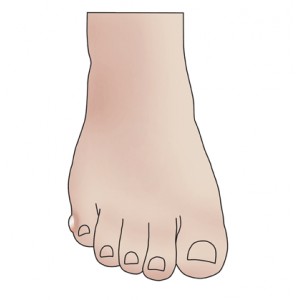Blisters
Blisters:A blister is a collection of fluid underneath the top layer of the skin (the epidermis). It is a defense mechanism, or "natural bandage", created by the body to help repair damaged skin. This picture shows what a blister on the side of the pinky toe can look like. Symptoms:One or more bubble-like areas of skin, ranging in size from a pinpoint to several inches, that are filled with clear fluid. Some blisters are accompanied by redness, itching and pain. Others may contain blood.
Causes:Friction is the most common cause of a blister on the foot, which occurs when skin continuously rubs against another surface, tears the upper layers of the skin and fills the injured area with fluid.
Shoes or hosiery that do not fit properly will likely create a blister. Other causes of blisters include burns, allergic reactions, infections or autoimmune disorders
Prevention:To prevent a blister on your foot, do one or more of the following:
Warning: We hope these suggestions improve your health and make you more comfortable. However, if you have any concerns about our advice, if any symptom persists for an unreasonable amount of time or if your condition worsens after self-treatment, we encourage you to consult a medical professional for further assistance.Please note, people with diabetes and poor circulation should always consult a medical professional before performing any self-treatment.
Causes:Friction is the most common cause of a blister on the foot, which occurs when skin continuously rubs against another surface, tears the upper layers of the skin and fills the injured area with fluid.
Shoes or hosiery that do not fit properly will likely create a blister. Other causes of blisters include burns, allergic reactions, infections or autoimmune disorders
Prevention:To prevent a blister on your foot, do one or more of the following:
- Wear properly-fitting hosiery and shoes, making sure to avoid ones that are too tight or too loose
- Inspect the inside of hosiery and shoes for seams or worn areas that might produce extra friction
- Cover friction-prone areas with a protective barrier, such as padding, powder or moisturizer
- Wear extra-protective or double-layered socks to help absorb friction within their fabric
- Keep feet cool and dry; Be sure to change hosiery or shoes that have absorbed excessive amounts of moisture, such as perspiration or water.
To help promote proper healing of a blister:
- Wash the blister and the surrounding skin with water and a disinfecting soap. If the blister is popped, do not remove the broken skin.
- Cut a hole just a little larger than the blister in a piece of protective padding, such as moleskin or felt, to help cushion the injured area from additional friction or pressure.
- Gently place the protective padding over the blister, making sure that any adhesive affixes to the healthy skin around the wound and not directly on the blistered skin.
- If the blister is open, you should also apply antibiotic ointment over the damaged skin and cover it with a piece of sterile gauze.
At least once a day, remove the dressing carefully and inspect the wound. If the blister shows no signs of infection, repeat the above steps with a new dressing.
If the wound becomes additionally painful or reddened, secretes colored pus, develops yellow crusting or does not show signs of healing after a few days, consult a medical professional for additional advice.
Warning: We hope these suggestions improve your health and make you more comfortable. However, if you have any concerns about our advice, if any symptom persists for an unreasonable amount of time or if your condition worsens after self-treatment, we encourage you to consult a medical professional for further assistance.Please note, people with diabetes and poor circulation should always consult a medical professional before performing any self-treatment.



